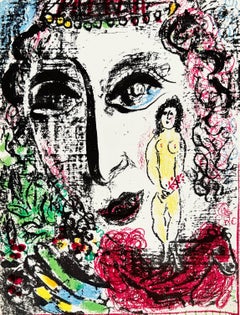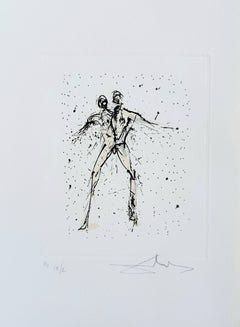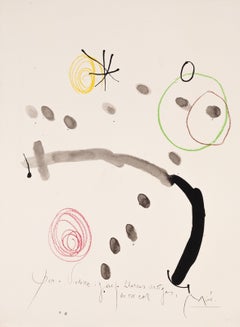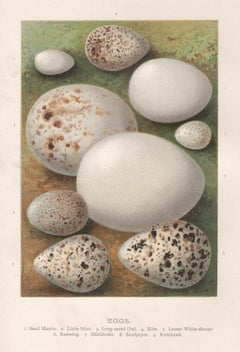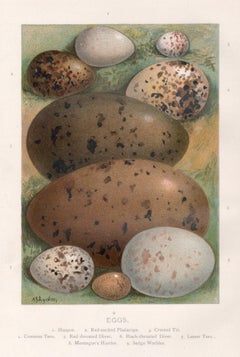Miniature More Prints
to
440
2,318
1,732
2,291
972
772
Overall Width
to
Overall Height
to
381
363
224
166
84
29
24
24
23
18
15
11
5
123
81
38
35
30
103
375
1,419
421
17
8
28
57
60
142
258
281
154
83
81
1,569
584
153
59
39
25
23
15
12
11
11
7
7
6
5
4
4
4
4
3
3
3
3
981
444
414
182
176
166
567
1,113
719
Size: Miniature
L'apparition au Cirque
By Marc Chagall
Located in OPOLE, PL
"Marc Chagall (1887-1985) - L'apparition au Cirque
Original Lithograph from 1960.
Dimensions of work: 32 x 24 cm.
Publisher: Maeght Éditeur, Paris.
The work is in Excellent condi...
Category
1960s Modern More Prints
Materials
Lithograph
$692 Sale Price
34% Off
Greek Decorative Motifs - Chromolithograph - Early 20th Century
Located in Roma, IT
Greek Decorative Motifs is a vintage chromolithograph realized by an anonymous artist of the early 20th Century.
Good conditions.
The artwork represents Greek Decorative motifs in ...
Category
Early 20th Century More Prints
Materials
Paper
Gemini
Located in OPOLE, PL
Salvador Dali (1904-1989) - Gemini
Etching from 1974.
The edition HC IX/L on Guarro paper.
Dimensions of work: 35 x 26.2 cm.
Hand signed.
Publisher: Léon Amiel, Paris - New York...
Category
1970s Surrealist More Prints
Materials
Etching
Quelques Fleurs No. 2: Artigas
By Joan Miró
Located in Columbia, MO
Quelques Fleurs pour des Amis: Dypréau No. 9
1964
Lithograph
Ed. Edition of 150
15 x 11 inches
Category
Mid-20th Century Abstract Abstract Prints
Materials
Lithograph
Eggs, natural history chromolithograph, circa 1900
Located in Melbourne, Victoria
'Eggs'
Antique English natural history chromolithograph. Key to eggs below the image. Tiny numbers in the margins to identify the eggs.
Sheet 19cm by 12.5cm, image 13cm by 9.5cm.
Category
Early 1900s Naturalistic Still-life Prints
Materials
Lithograph
Eggs, natural history chromolithograph, circa 1900
Located in Melbourne, Victoria
'Eggs'
Antique English natural history chromolithograph. Key to eggs below the image. Tiny numbers in the margins to identify the eggs.
Sheet 19cm by 12.5cm, image 13cm by 9.5cm.
Category
Early 1900s Naturalistic Still-life Prints
Materials
Lithograph
Les Amours de Cassandre Complete Suite
Located in Hollywood, FL
ARTIST: Salvador Dali
TITLE: Les Amours de Cassandre Complete Suite
MEDIUM: 10 Etchings
SIGNED: Each etching is Hand Signed
PUBLISHER: Editions Argillet, Paris
EDITION NUMBER:...
Category
1960s Surrealist More Prints
Materials
Etching
Still Life with a Glass
Located in OPOLE, PL
Bernard Buffet (1928-1999) - Still Life with a Glass
Lithograph from 1968.
Dimensions of work: 31 x 24 cm
Publisher: André Sauret, Monte Carlo.
Printed by: Fernand Mourlot, Paris...
Category
1960s Expressionist More Prints
Materials
Lithograph
$367 Sale Price
20% Off
Franciscea Grandiflora, English antique flower chromolithograph, 1896
Located in Melbourne, Victoria
'1. Franciscea Grandiflora 2. Euphorbia Jacqueniaelfora (Fulgens) 3. Gardenia Intermedia'
Antique English flower botanical chromolithograph.
Category
Late 19th Century Naturalistic Still-life Prints
Materials
Lithograph
Siena [Large Version] - British Modernism Italian Architecture Siena
Located in London, GB
This original etching and drypoint is hand signed in pencil by the artist "Nicholson" at the lower left margin and dated “65” next to the signature.
It is also hand numbered from the...
Category
1960s Modern More Prints
Materials
Drypoint, Etching
Hommage à San Lazzaro
By Max Ernst
Located in OPOLE, PL
Max Ernst (1891-1976) - Hommage à San Lazzaro
Lithograph from 1975.
Edition 371/575 (Photocopy of the colophone is included).
Dimensions of work: 31 x 24 cm.
Plate signed.
Each ...
Category
1970s Modern More Prints
Materials
Lithograph
$1,132 Sale Price
20% Off
1939 Original Keep Calm and Carry On Poster (small size) Second World War Two
Located in London, GB
Ernest Wallcousins (1882-1976), UK 1939
Keep Calm and Carry On (Small size)
Ministry of Information
Lithographic poster
37 x 25 cm
Very rare - we have traced copies in the Imperial ...
Category
1930s Modern More Prints
Materials
Lithograph
The Taste of Happiness, Planche LII
Located in OPOLE, PL
Pablo Picasso (1881-1973) - The Taste of Happiness, Planche LII
Lithograph from 1970.
An unsigned and unnumbered edition of 666.
Dimensions of sheet: 32.5 x 25 cm
Dimensions in f...
Category
1970s Modern More Prints
Materials
Lithograph
Cornflowers and Daylily diptych
By Jane Peart
Located in Deddington, GB
Cornflowers by Jane Peart [2020]
original
Acrylic
Image size: H:30 cm x W:30 cm
Complete Size of Unframed Work: H:30 cm x W:30 cm x D:3.5cm
Sold Unframed
Please note that insitu ima...
Category
21st Century and Contemporary Contemporary Figurative Prints
Materials
Canvas, Acrylic
Adveniat Regnuum Tuum - Lithograph Attr. to S. Dali - 1964
Located in Roma, IT
Adveniat Regnuum Tuum is an original lithograph by Salvador Dalí (1904 – 1989), from the volume "Pater Noster" published by Rizzoli Editore, Milan, 1964.
Signed and dated "1964" on plate on the lower left margin. In excellent conditions.
Reference: R. Michel, L. W. Löpsinger, Dalì, Catalogue Raisonné of Prints II, Lithographs and Wood engravings, 1956-1980, p. 180, n. 1599.
Pater Noster is a beautiful artists' book illustrated by the oldest and mystic Salvador Dalí. Nine colored plates protected by Japanese paper represent the verses of the Lord's Prayer. The pages of a 14th-century missal reproduce a Pater Noster in Gregorian chant...
Category
1960s Surrealist More Prints
Materials
Lithograph
Juste Présent
Located in OPOLE, PL
Sonia Delaunay (1885-1979) - Juste Présent
Lithograph from 1961.
Dimensions of work: 38 x 28 cm
Publisher: Lacourière et Frélaut, Paris.
The work is in Excellent condition.
Fast...
Category
1960s Expressionist More Prints
Materials
Lithograph
$1,132 Sale Price
20% Off
Faune Dévoilant une Dormeuse
Located in Berlin, DE
Signed in pencil lower right 'Picasso'. Plate 27 of the 'Suite Vollard'. One of 250 impressions. Paris, Édition Vollard, 1939. On Montval-wove paper watermarked 'Vollard'. One of th...
Category
1930s More Prints
Materials
Aquatint, Black and White
Orange labyrinth - XXI Century, Contemporary Linocut & Woodcut Print, Abstract
Located in Warsaw, PL
MARIA STELMASZCZYK (born in 1983) Studies at the Faculty of Graphic Arts and Painting
Laboratory of Woodcut Techniques and Artistic Book at the Academy of Fine Arts Władysław Strzemi...
Category
Early 2000s Contemporary Abstract Prints
Materials
Paper, Linocut, Woodcut
Rosace
Located in OPOLE, PL
Henri Matisse (1869-1954) - Rosace
Lithograph from 1958.
Dimensions of work: 35.5 x 26.4 cm
Plate signed.
Publisher: Tériade, Paris.
First, original edition.
The work is in Exc...
Category
1950s Surrealist More Prints
Materials
Lithograph
Constellation - XXI Century, Contemporary Linocut & Woodcut Print, Abstract
Located in Warsaw, PL
MARIA STELMASZCZYK (born in 1983) Studies at the Faculty of Graphic Arts and Painting
Laboratory of Woodcut Techniques and Artistic Book at the Academy of Fine Arts Władysław Strzemi...
Category
Early 2000s Contemporary Abstract Prints
Materials
Paper, Linocut, Woodcut
The Taste of Happiness, Planche XLIV
Located in OPOLE, PL
Pablo Picasso (1881-1973) - The Taste of Happiness, Planche XLIV
Lithograph from 1970.
An unsigned and unnumbered edition of 666.
Dimensions of sheet: 32.5 x 25 cm
Dimensions in ...
Category
1970s Modern More Prints
Materials
Lithograph
Silver Gem, Limited Edition Print, Contemporary Art
By Chris Keegan
Located in Deddington, GB
This multi-coloured Gemstone is hand-printed in florescent Yellow, Blue and metallic Silver ink. Then finished off by hand drawing over the print with multi-coloured paint. The Silve...
Category
2010s Contemporary More Prints
Materials
Paper, Screen
Champignons, French antique mushroom fungi chromolithograph, 1910
Located in Melbourne, Victoria
'71. Lactarius rufus 72. Lactarius volemus 73. Lactarius subdulcis 74. Lactarius camphoratus'
Antique French mushroom / fungi chromolithograph.
From "Atlas des champignons de Franc...
Category
Early 20th Century Naturalistic Still-life Prints
Materials
Lithograph
La Comédie Humaine
Located in OPOLE, PL
Pablo Picasso (1881-1973) - La Comédie Humaine
Lithograph from 1954.
Dimensions of work: 35.5 x 26.5 cm
Publisher: Tériade, Paris.
The work is in Excellent condition.
Fast and s...
Category
1950s Modern Figurative Prints
Materials
Lithograph
French Mid-Century 1970s Fashion Design Vintage Lithograph Print
Located in Melbourne, Victoria
Original colour lithograph of a French fashion design from 'Haute Couture'. Published in a folio of designs for Summer 1971.
32cm by 22cm (sheet)
Category
1970s Post-War Figurative Prints
Materials
Lithograph
Carlotta Auba by Simon Tozer, Limited edition print, Sailing, Coastal
Located in Deddington, GB
Carlotta Auba by Simon Tozer [2022]
limited_edition and hand signed by the artist
Screenprint on Paper
Edition number of 18
Image size: H:23.5 cm x W:3...
Category
21st Century and Contemporary Expressionist Landscape Prints
Materials
Paper, Screen
Prague, Czechoslovakia. Antique Map City Plan Chromolithograph, circa 1895
Located in Melbourne, Victoria
'Prag'
Colour lithograph. 1895.
250mm by 305mm (sheet).
Late 19th century German lithograph plan of Prague, Czechoslovakia.
Central vertical fold. Printed street index on the ...
Category
Late 19th Century Victorian More Prints
Materials
Lithograph
Stabisme Pastoral
By Asger Jorn
Located in OPOLE, PL
Asger Jorn (1914-1973) - Stabisme Pastoral
Lithograph from 1968.
Dimensions of work: 45 x 32 cm
Printed by Clot, Bramsen and Georges, Paris
The work is in Excellent condition.
F...
Category
1960s Surrealist More Prints
Materials
Lithograph
Marte - Etching by Umberto Mastroianni - 1970s
Located in Roma, IT
Marte is a modern artwork realized by Umberto Mastroianni in 1970s.
Mixed colored etching
Hand signed, numbered and titled on the lower margin
Edition of 48/75
Includes frame: 65...
Category
1970s Abstract More Prints
Materials
Etching
54: Petromyzon fluviatilis, Lampern, or Lesser Lamprey
Located in Columbia, MO
Edward Donovan (1768–1837) was an Anglo Irish writer, natural history illustrator and amateur zoologist. Born in Cork, Ireland, Donovan was an avid collector of natural history speci...
Category
Early 1800s Naturalistic Animal Prints
Materials
Color, Etching
Marc Chagall - Original Lithograph
By Marc Chagall
Located in Collonge Bellerive, Geneve, CH
Marc Chagall
Original Lithograph
1963
Dimensions: 32 x 24 cm
Reference: Chagall Lithographe 1957-1962. VOLUME II.
Condition : Excellent
Marc Chagall (born in 1887)
Marc Chagall was born in Belarus in 1887 and developed an early interest in art. After studying painting, in 1907 he left Russia for Paris, where he lived in an artist colony on the city’s outskirts. Fusing his own personal, dreamlike imagery with hints of the fauvism and cubism popular in France at the time, Chagall created his most lasting work—including I and the Village (1911)—some of which would be featured in the Salon des Indépendants exhibitions. After returning to Vitebsk for a visit in 1914, the outbreak of WWI trapped Chagall in Russia. He returned to France in 1923 but was forced to flee the country and Nazi persecution during WWII. Finding asylum in the U.S., Chagall became involved in set and costume design before returning to France in 1948. In his later years, he experimented with new art forms and was commissioned to produce numerous large-scale works. Chagall died in St.-Paul-de-Vence in 1985.
The Village
Marc Chagall was born in a small Hassidic community on the outskirts of Vitebsk, Belarus, on July 7, 1887. His father was a fishmonger, and his mother ran a small sundries shop in the village. As a child, Chagall attended the Jewish elementary school, where he studied Hebrew and the Bible, before later attending the Russian public school. He began to learn the fundamentals of drawing during this time, but perhaps more importantly, he absorbed the world around him, storing away the imagery and themes that would feature largely in most of his later work.
At age 19 Chagall enrolled at a private, all-Jewish art school and began his formal education in painting, studying briefly with portrait artist Yehuda Pen. However, he left the school after several months, moving to St. Petersburg in 1907 to study at the Imperial Society for the Protection of Fine Arts. The following year, he enrolled at the Svanseva School, studying with set designer Léon Bakst, whose work had been featured in Sergei Diaghilev's Ballets Russes. This early experience would prove important to Chagall’s later career as well.
Despite this formal instruction, and the widespread popularity of realism in Russia at the time, Chagall was already establishing his own personal style, which featured a more dreamlike unreality and the people, places and imagery that were close to his heart. Some examples from this period are his Window Vitebsk (1908) and My Fianceé with Black Gloves (1909), which pictured Bella Rosenfeld, to whom he had recently become engaged.
The Beehive
Despite his romance with Bella, in 1911 an allowance from Russian parliament member and art patron Maxim Binaver enabled Chagall to move to Paris, France. After settling briefly in the Montparnasse neighborhood, Chagall moved further afield to an artist colony known as La Ruche (“The Beehive”), where he began to work side by side with abstract painters such as Amedeo Modigliani and Fernand Léger as well as the avant-garde poet Guillaume Apollinaire. At their urging, and under the influence of the wildly popular fauvism and cubism, Chagall lightened his palette and pushed his style ever further from reality. I and the Village (1911) and Homage to Apollinaire (1912) are among his early Parisian works, widely considered to be his most successful and representative period.
Though his work stood stylistically apart from his cubist contemporaries, from 1912 to 1914 Chagall exhibited several paintings at the annual Salon des Indépendants exhibition, where works by the likes of Juan Gris, Marcel Duchamp and Robert Delaunay were causing a stir in the Paris art world. Chagall’s popularity began to spread beyond La Ruche, and in May 1914 he traveled to Berlin to help organize his first solo exhibition, at Der Sturm Gallery. Chagall remained in the city until the highly acclaimed show opened that June. He then returned to Vitebsk, unaware of the fateful events to come.
War, Peace and Revolution
In August 1914 the outbreak of World War I precluded Chagall’s plans to return to Paris. The conflict did little to stem the flow of his creative output, however, instead merely giving him direct access to the childhood scenes so essential to his work, as seen in paintings such as Jew in Green (1914) and Over Vitebsk (1914). His paintings from this period also occasionally featured images of the war’s impact on the region, as with Wounded Soldier (1914) and Marching (1915). But despite the hardships of life during wartime, this would also prove to be a joyful period for Chagall. In July 1915 he married Bella, and she gave birth to a daughter, Ida, the following year. Their appearance in works such as Birthday (1915), Bella and Ida by the Window (1917) and several of his “Lovers” paintings give a glimpse of the island of domestic bliss that was Chagall’s amidst the chaos.
To avoid military service and stay with his new family, Chagall took a position as a clerk in the Ministry of War Economy in St. Petersburg. While there he began work on his autobiography and also immersed himself in the local art scene, befriending novelist Boris Pasternak, among others. He also exhibited his work in the city and soon gained considerable recognition. That notoriety would prove important in the aftermath of the 1917 Russian Revolution when he was appointed as the Commissar of Fine Arts in Vitebsk. In his new post, Chagall undertook various projects in the region, including the 1919 founding of the Academy of the Arts. Despite these endeavors, differences among his colleagues eventually disillusioned Chagall. In 1920 he relinquished his position and moved his family to Moscow, the post-revolution capital of Russia.
In Moscow, Chagall was soon commissioned to create sets and costumes for various productions at the Moscow State Yiddish Theater...
Category
1960s Surrealist Figurative Prints
Materials
Lithograph
Arabian Women - Woodcut by Moses Levy - XX Century
Located in Roma, IT
Arabian Women is an original woodcut on yellowish paper realized by Moses Levy. Signed and titled in Italian" Donne Arabe".
The State of preservation is very good.
Included a Passepartout:
The artwork represents three Arabian women, through confident and strong strokes in intense black, The artwork is made by the Expressionistic style of creation, the contrast between black and white are well defined.
Moses Levy (Italian, 1885–1968) In 1900 he enrolled at the Institute of Fine Arts in Lucca and found Lorenzo Viani as a fellow student. Levy and Viani also attend courses at the Nude School of the Academy of Fine Arts held by the painter Giovanni Fattori together in Florence. During this period, Levy became passionate about graphics and came into contact with Renato Natali...
Category
20th Century Figurative Prints
Materials
Woodcut
$383 Sale Price
35% Off
Shafts of Light, Limited Edition Woodland Print, Japanese Style Screen Print
By Chris Keegan
Located in Deddington, GB
The inspiration for this print is to capture the momentary spectacle when shafts of light cast themselves through a densely packed woodland canopy. The print boasts a vibrant array of four stunning colours, featuring an under-layer of metallic Gold ink and finished off with a subtle lush green overprint. Artwork printed...
Category
2010s Impressionist Landscape Prints
Materials
Archival Paper, Screen
Gothic Decorative Motifs - Vintage Chromolithograph - Early 20th Century
Located in Roma, IT
Gothic Decorative Motifs is a vintage chromolithograph realized by an anonymous artist in the early 20th Century.
Good conditions.
The artw...
Category
Early 20th Century More Prints
Materials
Paper, Lithograph
Le Sept Péchés Capitaux
By Marc Chagall
Located in OPOLE, PL
Marc Chagall (1887-1985) - Le Sept Péchés Capitaux
Etching from 1925.
Edition of 300 proofs.
Dimensions of work: 25 x 19.5 cm.
Publisher: Tériade, Paris.
Reference: Kornfeld 47....
Category
1920s Symbolist More Prints
Materials
Etching
$839 Sale Price
20% Off
Cottonwoods II
Located in Palm Springs, CA
Signed, numbered, and titled by the artist from the edition of 200. Winter scene of cottonwoods in a field with a dusting of snow.
Smith-Harrision's work very often features architectural elements, along with trees. This is one his largest prints, which took him two years to complete. The ornate imagery of spanish tile that borders the lower half of the print needs to be seen in person to be fully appreciated. The two palms are specific trees that Smith-Harrison encountered on a trip to Spain.
David Smith...
Category
Early 2000s Contemporary More Prints
Materials
Etching, Aquatint
Decorative Motifs of Egyptian Renaissance - Chromolithograph -Early 20th Century
Located in Roma, IT
Decorative Motifs of the Egyptian Renaissance is a vintage chromolithograph by an anonymous artist.
Good conditions.
The artwork represents Decorative motifs of the Egyptian Renais...
Category
Early 20th Century More Prints
Materials
Paper, Lithograph
Apple of Sodom (Solanum - sodomaeum, Linne), antique botanical plant lithograph
Located in Melbourne, Victoria
'Apple of Sodom (Solanum - sodomaeum, Linne)'
Colour lithograph, 1909.
Category
Early 20th Century Naturalistic More Prints
Materials
Lithograph
Warning, be on your guard - Original vintage Second World War poster
Located in London, GB
Original vintage Second World War poster
'Warning, be on your guard'
Lithograph
38 x 25 cm
'Warning, be on your guard. Thousands of lives were lost in the last war because valuabl...
Category
Mid-20th Century Realist More Prints
Materials
Lithograph
The Taste of Happiness, Planche XXXIX
Located in OPOLE, PL
Pablo Picasso (1881-1973) - The Taste of Happiness, Planche XXXIX
Lithograph from 1970.
An unsigned and unnumbered edition of 666.
Dimensions of sheet: 32.5 x 25 cm
Dimensions in...
Category
1970s Modern More Prints
Materials
Lithograph
Faune
Located in OPOLE, PL
Pablo Picasso (1881-1973) - Faune
Lithograph from 1957.
The edition 211/275.
Dimensions of work: 44.5 x 33.5 cm.
Publisher: Fernand Mourlot Éditeur, Paris.
Reference: Bloch 793;...
Category
1950s Modern More Prints
Materials
Lithograph
$1,415 Sale Price
20% Off
Bienaimé Parfums, Paris 1947 Lithograph Print on Embossed Paper
Located in Richmond, GB
Charming detailed lithographs published by Draeger, Paris 1947 for the perfume house Bienaimé. Printed in colours and highlighted in gold and silver on embossed paper...
Category
20th Century More Prints
Materials
Gold, Silver
Pierre Bonnard Ltd Ed Lithograph Printed at Mourlot Paris 1958 Sail Boats, Lake
Located in Surfside, FL
This is from a limited edition portfolio of original lithographs print Fernand Mourlot in Paris in 1958 from work done in collaboration with Bonnard which began in 1928.
This is f...
Category
20th Century Post-Impressionist More Prints
Materials
Lithograph
Japanese Decorative Motifs - Vintage Chromolithograph - Early 20th Century
Located in Roma, IT
Japanese Decorative Motifs is a vintage chromolithograph realized by an anonymous artist in the early 20th Century.
Good conditions.
The artwork rep...
Category
Early 20th Century More Prints
Materials
Paper, Lithograph
Tah-Ro-Hon, An Ioway Warrior: Original Hand-colored McKenney & Hall Lithograph
Located in Alamo, CA
This is an original 19th century hand-colored McKenney and Hall lithograph of a Native American entitled "Tah-Ro-Hon, An Ioway Warrior", lithographed by J. T. Bowen after a painting by Charles Bird King and published by Rice and Hart & Co. in Philadelphia in 1848. For his portrait Tah-Ro-Hon is wearing a feathered multicolored headdress, long ornamental earrings, a chain necklace, a presidential piece medal on a ribbon necklace and he holds a multicolored staff with feathers.
This original McKenney and Hall hand-colored lithograph is printed on a sheet measuring 10" high and 7" wide. There is a tiny spot of red paint adjacent to a red feather hanging...
Category
Mid-19th Century Naturalistic Portrait Prints
Materials
Lithograph
Untitled - Original Lithograph by Primo Conti - 1973
Located in Roma, IT
Untitled is a beautiful original colored lithograph on cream-colored paper realized by the Italian artist Primo Conti (1900-1988).
An original print, repr...
Category
1970s Contemporary More Prints
Materials
Lithograph
The Taste of Happiness, Planche X
Located in OPOLE, PL
Pablo Picasso (1881-1973) - The Taste of Happiness, Planche X
Lithograph from 1970.
An unsigned and unnumbered edition of 666.
Dimensions of sheet: 32.5 x 25 cm
Dimensions in fra...
Category
1970s Modern More Prints
Materials
Lithograph
Le Sept Péchés Capitaux
By Marc Chagall
Located in OPOLE, PL
Marc Chagall (1887-1985) - Le Sept Péchés Capitaux
Etching from 1925.
Edition of 300 proofs.
Dimensions of work: 25 x 19.5 cm.
Publisher: Tériade, Paris.
Reference: Kornfeld 47....
Category
1920s Symbolist More Prints
Materials
Etching
$839 Sale Price
20% Off
Angel Serving Dinner Woodcut by Tim Engelland
Located in New York, NY
Tim Engelland (American, 1950-2012)
Untitled, c. 1990
Woodcut
11 x 8 1/2 in.
Signed and numbered bottom right: T. Engelland, 161/250
A lifelong artist,...
Category
1990s Modern More Prints
Materials
Woodcut
A General
Located in OPOLE, PL
Pablo Picasso (1881-1973) - A General
Phototype and pochoir from 1962.
From the edition of 1,000 copies, this example is number 334, as noted in the colophon.
Dimensions of sheet:...
Category
1960s Modern More Prints
Materials
Stencil
$452 Sale Price
20% Off
Colombe sur fond vert
Located in OPOLE, PL
Georges Braque (1882-1963) - Colombe sur fond vert
Lithograph from 1975.
Edition 371/575 (Photocopy of the colophone is included).
Dimensions of work: 31 x 24 cm.
Plate signed.
...
Category
1970s Modern More Prints
Materials
Lithograph
$849 Sale Price
20% Off
Urbi
Located in OPOLE, PL
Pablo Picasso (1881-1973) - Urbi
Phototype and pochoir from 1962.
From the edition of 1,000 copies, this example is number 334, as noted in the colophon.
Dimensions of sheet: 40 x...
Category
1960s Modern More Prints
Materials
Stencil
$452 Sale Price
20% Off
Helvella Crispa, Leuba antique mushroom fungi chromolithograph print
Located in Melbourne, Victoria
'1-2 Helvella Crispa 3-6 Peziza Repanda' (White Saddle and Palomino cup)
Antique Swiss mushroom / fungi chromolithograph, lithographed by H Furrer after ...
Category
Late 19th Century Naturalistic Still-life Prints
Materials
Lithograph
Femme Bleue
Located in OPOLE, PL
Henri Matisse (1869-1954) - Femme Bleue
Lithograph from 1958.
Dimensions of work: 35.5 x 26.4 cm
Plate signed.
Publisher: Tériade, Paris.
On the verso there is another Lithograp...
Category
1950s Surrealist More Prints
Materials
Lithograph
$849 Sale Price
20% Off
Art Nouveau "Glasgow Rose" original lithograph by Charles Rennie Mackintosh
Located in Palm Beach, FL
Charles Rennie Mackintosh was a Scottish architect, designer, and visual artist. His artistic approach had much in common with European Symbolism. His work, alongside that of his wife Margaret Macdonald, was influential on European design movements such as Art Nouveau and Secessionism and praised by great modernists such as Josef Hoffmann. Mackintosh was born in Glasgow and died in London. He is among the most important figures of Modern Style (British Art Nouveau...
Category
Early 1900s Art Nouveau More Prints
Materials
Lithograph
Henri Matisse - Fruits - Original Lithograph
Located in Collonge Bellerive, Geneve, CH
Henri Matisse - Fruits - Original Lithograph
1964
Dimensions: 30 x 20 cm
Edition of 200 (one of the 200 on Vélin de Rives)
Mourlot Press, 1964
Unsigned and unumbered as issued
Category
1960s Modern Abstract Prints
Materials
Lithograph
Cavalier et la mort (Knight and Death)
Located in OPOLE, PL
Salvador Dali (1904-1989) - Cavalier et la mort (Knight and Death)
Drypoint etching with roulette from 1969.
The edition 142/145.
Dimensions of work: 38 x 28 cm.
Hand signed.
Pu...
Category
1970s Surrealist More Prints
Materials
Drypoint, Etching
The Man with the Bird
Located in OPOLE, PL
Pablo Picasso (1881-1973) - The Man with the Bird
Phototype and pochoir from 1962.
From the edition of 1,000 copies, this example is number 334, as noted in the colophon.
Dimensio...
Category
1960s Modern More Prints
Materials
Stencil
$452 Sale Price
20% Off
Sheridan Square
By Marc Yankus
Located in New York, NY
Archival pigment print
Signed, titled, numbered, and dated, verso
17 x 11 inches, sheet
(Edition of 15)
22 x 17 inches, sheet
(Edition of 15)
This artwork is offered by ClampArt, ...
Category
Early 2000s Contemporary Color Photography
Materials
Archival Pigment
The Wolf, the Mother, and the Child
By Marc Chagall
Located in OPOLE, PL
Marc Chagall (1887-1985) - The Wolf, the Mother, and the Child
Etching from 1954.
Edition of 85.
Enhanced with watercolour by the artist.
Dimensions of work: 39 x 30 cm.
Referen...
Category
1950s Modern More Prints
Materials
Etching
Recently Viewed
View AllMore Ways To Browse
Delta Poster
Ed Ruscha Sin With Olive
Ed Ruscha Sin
Ewan David Eason
Florida Vintage Travel Posters
Goodyear Poster
Gustav Klutsis
Ihap Hulusi
Ivan Navarro
James B Painter
James Bond Movie Posters
Jan V Roy Posters
John Lennon On Sale
Lait Pur Sterilize
Lake District Vintage Travel Poster
Land Rover Poster
Le Frou Frou Vintage Poster
Leon De Pas
